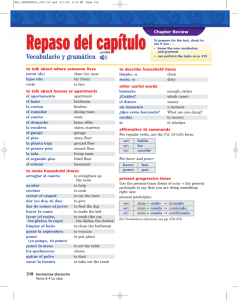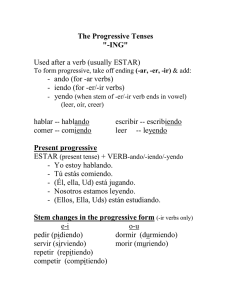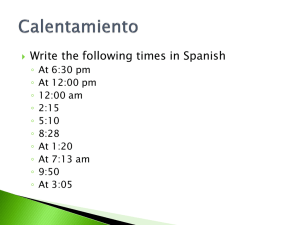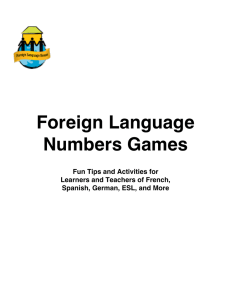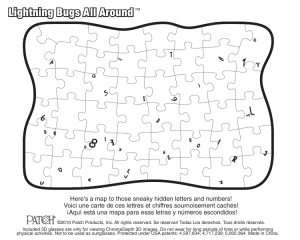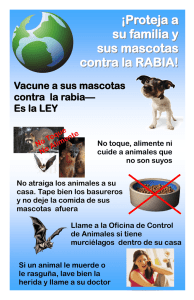Resumen Español Spanish Summary
Anuncio
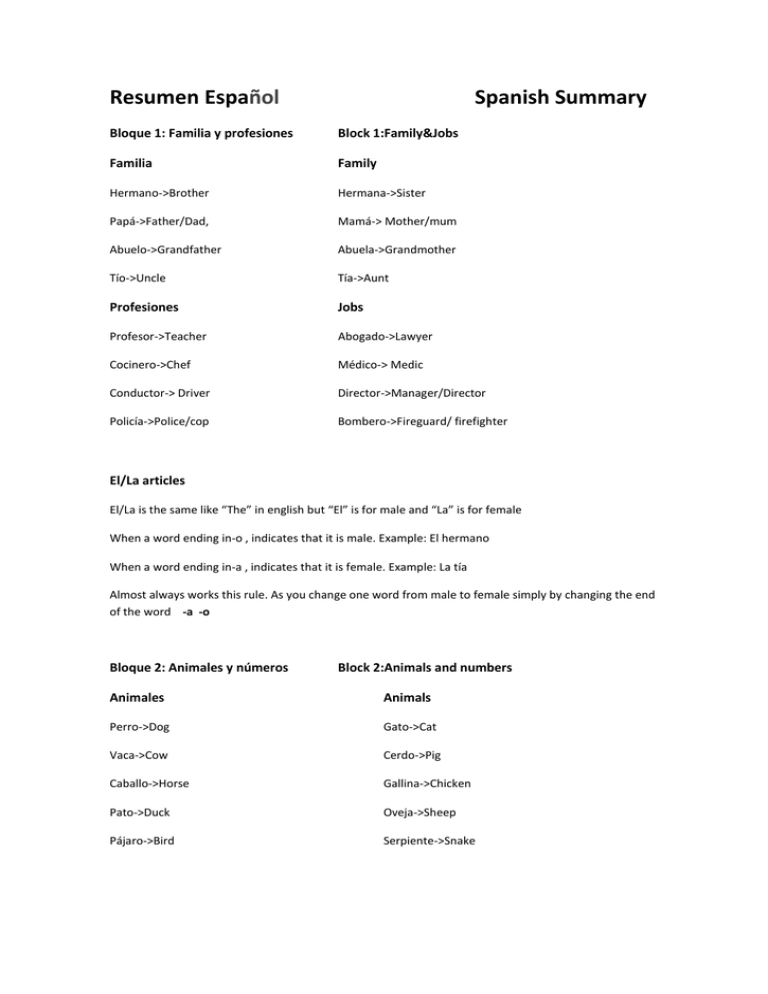
Resumen Español Spanish Summary Bloque 1: Familia y profesiones Block 1:Family&Jobs Familia Family Hermano->Brother Hermana->Sister Papá->Father/Dad, Mamá-> Mother/mum Abuelo->Grandfather Abuela->Grandmother Tío->Uncle Tía->Aunt Profesiones Jobs Profesor->Teacher Abogado->Lawyer Cocinero->Chef Médico-> Medic Conductor-> Driver Director->Manager/Director Policía->Police/cop Bombero->Fireguard/ firefighter El/La articles El/La is the same like “The” in english but “El” is for male and “La” is for female When a word ending in-o , indicates that it is male. Example: El hermano When a word ending in-a , indicates that it is female. Example: La tía Almost always works this rule. As you change one word from male to female simply by changing the end of the word -a -o Bloque 2: Animales y números Block 2:Animals and numbers Animales Animals Perro->Dog Gato->Cat Vaca->Cow Cerdo->Pig Caballo->Horse Gallina->Chicken Pato->Duck Oveja->Sheep Pájaro->Bird Serpiente->Snake Números 1 al 20 1->Uno 6->Séis 11->Once 16->Dieciséis 2->Dos 7->Siete 12->Doce 17->Diecisiete 3->Tres 8->Ocho 13->Trece 18->Dieciocho 4->Cuatro 9->Nueve 14->Catorce 19->Diecinueve 5->Cinco 10->Diez 15->Quince 20->Veinte 21 al 29 Always have the same origin; “Veinti-“ and the unit number. 21 VEINTIuno 23 VEINTItres 28->VEINTIocho 22 VEINTIdos 24 VEINTIcuatro 29->VEINTInueve 30 al 100 You must enter the correct dozen (30,40,50…) and then write the unit with “Y”(and) 31-> Treinta y uno 46->Cuarenta y séis 72->Setenta y dos 30->Treinta 40->Cuarenta 50->Cincuenta 60->Sesenta 70->Setenta 80->Ochenta 90->Noventa 100->Cien For more information, see the paper with the numbers 1 to 100. Bloque 3 :Comidas y verbos acabados en -ar Block 3: Meals and verb finish in -ar Comidas Carne->Meat Verduras->Vegetables Frutas->Fruits Pollo->Chicken Tomate->Tomato Manzana->Apple Ternera->Beef Patata->Potato Naranja->Orange Salchicha->Sausage Pimiento->Pepper Plátano->Banana Queso->Cheese Huevos->Eggs Helado->Ice cream Zumo->Juice Arroz->Rice Pescado->Fish Verbos acabados en –AR Verbs finish in -AR In Spain we have 3 forms for verbs; finish in “-ar”,”-er”,”-ir” I will explain the rules for verbs ending in “-ar” for present: To conjugate the verb in Spanish well we write the verb without end “-ar”. Then we apply the correct termination depending on the person we are talking about (I,you,He…/Yo,tú,él…) For the present, the rule is: Yo ————> -o Tú————-> -as Él————–> -a Nosotros—–>-amos Vosotros—–>-áis Ellos/Ellas—>-an Example of verbs finish in –AR : Cantar, Bailar, Saltar, Hablar… (sing, dance, jump, speak) This rule does not always work, but usually does the job. Example: Gustar (like) For more information, see on the website. Extra Info Frases y palabras Phrases and words Buenos días-> Good morning Hola-> Hello Buenas tardes->Good afternoon Adiós->Goodbye Buenas noches-> Good night Por favor->Please ¿Cómo te llamas? ->What is your name? ¿Cuántos años tienes? -> How old are you? ¿Qué es esto? -> What is this ¿Cuánto vale/cuesta? -> How much is it? ? ¿De qué color es…? ->What color is the…? ¿Puedo ir al …? -> Can I go to the…? Días de la semana Days of the week Lunes->Monday Jueves-> Thursday Martes->Tuesday Viernes->Friday Miércoles-> Wednesday Sábado->Saturday Domingo->Sunday Meses Months Enero->January Mayo->May Septiembre->September Febrero->February Junio->June Octubre->October Marzo->March Julio->July Noviembre->November Abril->April Agosto->August Diciembre->December


